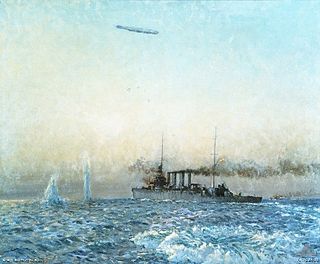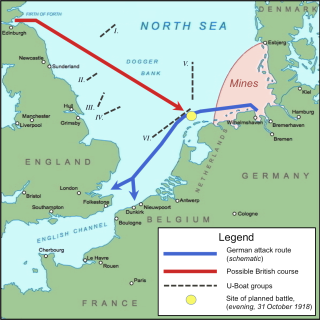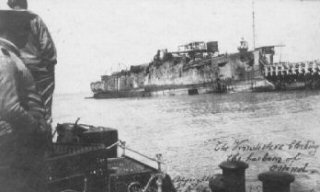 W
WThe 6th Cruiser Squadron was a formation of cruisers of the British Royal Navy from 1909 to 1915 and again in 1925 to 1945.
 W
WThe 7th Cruiser Squadron was a blockading force of the Royal Navy during the First World War used to close the English Channel to German traffic. It was employed patrolling an area of the North Sea known as the Broad Fourteens in support of vessels guarding the northern entrance to the Channel. The Squadron had been part of the Third Fleet of the Home Fleets.
 W
WThe Action of 22 September 1914 was an attack by the German U-boat U-9 that took place during the First World War. Three obsolete Royal Navy cruisers of the 7th Cruiser Squadron, manned mainly by reservists and sometimes referred to as the Live Bait Squadron, were sunk by U-9 while patrolling the southern North Sea.
 W
WThe Action of 29 February 1916 was a naval engagement fought during the First World War between the United Kingdom and the German Empire. SMS Greif a German commerce raider, broke out into the North Sea and Admiral Sir John Jellicoe dispatched Royal Navy warships to intercept the raider. Four British vessels made contact with the Greif and in the ensuing encounter, the commerce raider and the armed merchant cruiser RMS Alcantara were sunk.
 W
WThe Action of 19 August 1916 was one of two attempts in 1916 by the German High Seas Fleet to engage elements of the British Royal Navy, following the mixed results of the Battle of Jutland, in the First World War. The lesson of Jutland for Germany had been the vital need for reconnaissance, to avoid the unexpected arrival of the British Grand Fleet during a raid. On this occasion four Zeppelins were deployed to scout the North Sea between Scotland and Norway for signs of British ships and four more scouted immediately ahead of German ships. Twenty-four German submarines participated off the English coast, in the southern North Sea and off the Dogger Bank.
 W
WThe Action of 5 November 1916 was a naval engagement of the First World War. The action was fought between a Royal Navy submarine and a dreadnought squadron of the Imperial German Navy. This action took place in the months after the Battle of Jutland and is significant in that it signalled a major shift in German naval policy.
 W
WThe Action of 16 March 1917 was a naval engagement in which the British armed boarding steamer Dundee and the Warrior-class armoured cruiser HMS Achilles fought and sank the German auxiliary cruiser SMS Leopard, which sank with all 319 hands and the six men of a British boarding party.
 W
WThe Action of 4 May 1917 was a naval and air engagement of the First World War in the North Sea. The action took place between the German Zeppelin LZ 92, several German submarines and a naval force led by the Australian light cruiser HMAS Sydney. The action was inconclusive with no casualties on either side, concluding when the Zeppelin had dropped all of its bombs and the cruisers had expended all of their anti-aircraft ammunition.
 W
WThe Action of 15 February 1918 was a naval engagement which occurred during the First World War. The action was fought between an Imperial German destroyer squadron and the lightly armed ships of the Dover Patrol in the Strait of Dover, English Channel.
 W
WThe convoy—a group of merchantmen or troopships traveling together with a naval escort—was revived during World War I (1914–18), after having been discarded at the start of the Age of Steam. Although convoys were used by the Royal Navy in 1914 to escort troopships from the Dominions, and in 1915 by both it and the French Navy to cover their own troop movements for overseas service, they were not systematically employed by any belligerent navy until 1916. The Royal Navy was the major user and developer of the modern convoy system, and regular transoceanic convoying began in June 1917. They made heavy use of aircraft for escorts, especially in coastal waters, an obvious departure from the convoy practices of the Age of Sail.
 W
WThe Battle of Dogger Bank was a naval engagement on 24 January 1915, near the Dogger Bank in the North Sea, during the First World War, between squadrons of the British Grand Fleet and the Kaiserliche Marine. The British had intercepted and decoded German wireless transmissions, gaining advance knowledge that a German raiding squadron was heading for Dogger Bank and ships of the Grand Fleet sailed to intercept the raiders.
 W
WThe Battle of Dogger Bank on 10 February 1916 was a naval engagement between the Kaiserliche Marine of the German Empire and the Royal Navy of the United Kingdom, during the First World War. Three German torpedo boat flotillas sortied into the North Sea and encountered the British 10th Mine-sweeping Flotilla near Dogger Bank. The German vessels eventually engaged the British vessels, after mistaking them for cruisers instead of minesweeping sloops. Knowing they were out-gunned, the British attempted to flee and in the chase, the sloop HMS Arabis was sunk, before the British squadron escaped. As the cruisers of the Harwich Force returned to port, the light cruiser HMS Arethusa struck a mine, ran aground and broke in two. Although the Germans were victorious, they inflated the victory by reporting that they had sunk two cruisers.
 W
WThe Battle of Dover Strait that occurred on 26–27 October 1916 was a naval battle of the First World War between Great Britain and the German Empire. Two and a half flotillas of German torpedo boats from the Flanders Flotilla launched a raid into the Dover Strait in an attempt to disrupt the Dover Barrage and destroy whatever Allied shipping could be found in the strait.
 W
WThe Second Battle of Dover Strait was a naval battle of the First World War, fought in the Dover Strait in April 1917 and should not be confused with the major Battle of Dover Strait in 1916. Two Royal Navy destroyers defeated a superior force of German Kaiserliche Marine torpedo boats. Two German torpedo boats were sunk; the British suffered damage to both destroyers.
 W
WThe Battle of Heligoland Bight was the first naval battle of the First World War, fought on 28 August 1914, between ships of the United Kingdom and Germany. The battle took place in the south-eastern North Sea, when the British attacked German patrols off the north-west German coast. The German High Seas Fleet was in harbour on the north German coast while the British Grand Fleet was out in the northern North Sea. Both sides engaged in long-distance sorties with cruisers and battlecruisers, with close reconnaissance of the area of sea near the German coast—the Heligoland Bight—by destroyer.
 W
WThe Second Battle of Heligoland Bight, also called the Action in the Helgoland Bight was an inconclusive naval engagement fought between British and German squadrons on 17 November 1917 during the First World War.
 W
WThe Battle of Jutland was a naval battle fought between Britain's Royal Navy Grand Fleet, under Admiral Sir John Jellicoe, and the Imperial German Navy's High Seas Fleet, under Vice-Admiral Reinhard Scheer, during the First World War. The battle unfolded in extensive manoeuvring and three main engagements, from 31 May to 1 June 1916, off the North Sea coast of Denmark's Jutland Peninsula. It was the largest naval battle and the only full-scale clash of battleships in that war. Jutland was the third fleet action between steel battleships, following the Battle of the Yellow Sea in 1904 and the decisive Battle of Tsushima in 1905, during the Russo-Japanese War. Jutland was the last major battle in world history fought primarily by battleships.
 W
WThe Action off Lerwick was a naval engagement on 17 October 1917 fought in the North Sea during the First World War. The German light, minelaying cruisers SMS Brummer and Bremse attacked a westbound convoy of twelve colliers and their escorts. The two escorting destroyers and nine neutral Scandinavian ships were sunk off Shetland, Scotland. Admiralty code breakers had uncovered the call signs of Bremse and Brummer and by direction finding knew that they had sailed from Wilhelmshaven to Lister Tief north of Sylt but an operation as far north as the Scandinavian collier route was not anticipated.
 W
WThe naval order of 24 October 1918 was a plan made by the German Admiralty at the end of World War I to provoke a decisive battle between the German High Seas Fleet and the British Grand Fleet in the southern North Sea. When the order to prepare for the sortie was issued on 29 October, mutiny broke out aboard the German ships. Despite the operation being cancelled, these in turn led to the more serious Kiel mutiny, which was the starting point of the November Revolution and the proclamation of the Weimar Republic.
 W
WThe Battle off Noordhinder Bank on 1 May 1915 was a naval action between a squadron of four British naval trawlers supported by a flotilla of four destroyers and a pair of German torpedo boats from the Flanders Flotilla. The battle began when the two torpedo boats were sent on a rescue mission and ran into a British patrol. The Germans fought with the patrolling trawlers until British destroyers from Harwich Force came to their aid and sank the vessels.
 W
WThe North Sea Mine Barrage, also known as the Northern Barrage, was a large minefield laid easterly from the Orkney Islands to Norway by the United States Navy during World War I. The objective was to inhibit the movement of U-boats from bases in Germany to the Atlantic shipping lanes bringing supplies to the British Isles. Rear Admiral Lewis Clinton-Baker, commanding the Royal Navy minelaying force at the time, described the barrage as the "biggest mine planting stunt in the world's history;" but larger fields containing more mines were laid during World War II.
 W
WThe First Ostend Raid was the first of two attacks by the Royal Navy on the German-held port of Ostend during the late spring of 1918 during the First World War. Ostend was attacked in conjunction with the neighbouring harbour of Zeebrugge on 23 April in order to block the vital strategic port of Bruges, situated 6 mi inland and ideally sited to conduct raiding operations on the British coastline and shipping lanes. Bruges and its satellite ports were a vital part of the German plans in their war on Allied commerce (Handelskrieg) because Bruges was close to the troopship lanes across the English Channel and allowed much quicker access to the Western Approaches for the U-boat fleet than their bases in Germany.
 W
WThe Second Ostend Raid was the later of two failed attempts made during the spring of 1918 by the United Kingdom's Royal Navy to block the channels leading to the Belgian port of Ostend as a part of its conflict with the German Empire during World War I. Due to the significant strategic advantages conferred by the Belgian ports, the Imperial German Navy had used Ostend as a base for their U-boat activities during the Battle of the Atlantic since 1915.
 W
WThe Raid on Scarborough, Hartlepool and Whitby on 16 December 1914, was an attack by the Imperial German Navy on the British ports of Scarborough, Hartlepool, West Hartlepool and Whitby. The attack resulted in 592 casualties, many of them civilians, of whom 137 died. The attack caused public outrage in Britain towards the German Navy and against the Royal Navy for its failure to prevent the raid.
 W
WThe Battle off Texel, also known as the Action off Texel or the Action of 17 October 1914, was a naval battle off the coast of the Dutch island of Texel during the First World War. A British squadron, comprising one light cruiser and four destroyers on a routine patrol, encountered the German 7th Half Flotilla of torpedo boats which was en route to the British coast to lay mines. The British forces attacked and the outgunned German force attempted to flee and then fought a desperate and ineffective action against the British force, which sank all four German boats.
 W
WThe Raid on Yarmouth, which took place on 3 November 1914, was an attack by the Imperial German Navy on the British North Sea port and town of Great Yarmouth. Little damage was done to the town since shells only landed on the beach, after German ships laying mines offshore were interrupted by British destroyers. HMS D5, a submarine, was sunk by a German mine as it attempted to leave harbour and attack the German ships. A German armoured cruiser was sunk after striking two German mines outside its home port.
 W
WThe Bombardment of Yarmouth and Lowestoft, often referred to as the Lowestoft Raid, was a naval battle fought during the First World War between the German Empire and the British Empire in the North Sea.
 W
WThe Zeebrugge Raid on 23 April 1918, was an attempt by the Royal Navy to block the Belgian port of Bruges-Zeebrugge. The British intended to sink obsolete ships in the canal entrance, to prevent German vessels from leaving port. The port was used by the Imperial German Navy as a base for U-boats and light shipping, which were a threat to Allied control of the English Channel and southern North Sea. Several attempts to close the Flanders ports by bombardment failed and Operation Hush, a 1917 plan to advance up the coast, proved abortive. As ship sinkings by U-boats increased, finding a way to close the ports became urgent and the Admiralty became more willing to consider a raid.